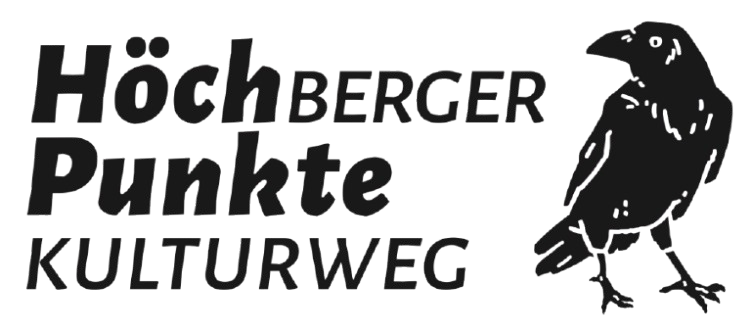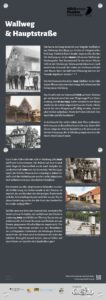Wallweg & Hauptstraße
The name Wallweg is derived from the route taken by pilgrims travelling from Würzburg to the church (Hauptstraße-Wallweg-Friedrich-Ebert-Straße-Jägerstraße-Kirche).
From the 1840s onwards, Wallweg was Höchberg’s new building area.
The building material for the new houses was supplied by the Höchberg factory sandstone quarry on the north-western edge of the town. The year of construction can still be seen on the façade of many of the houses that have been preserved to this day.1, 2 , 4
The 1250th anniversary memorial in the corner of this square documents several spellings of the town’s name Höchberg.
The 1250th anniversary memorial in the corner of this square documents several spellings of the town’s name Höchberg.
The crucifix with the year 1776 on a stone sphere on the base stood further east in the main street in front of the former Zur Traube inn until the air raid on Easter Sunday, 1 April 1945.
This was completely destroyed in the air raid, but was rebuilt afterwards. Today it houses a pharmacy and the savings bank. 3
The seventh station of the so-called Seven Falls of Christ is integrated into the façade of the residential building to the right of the square. This is a shortened Way of the Cross that begins in Würzburg and ends at the Church of Virgin Mary`s Nativity.
The seventh station of the so-called Seven Falls of Christ is integrated into the façade of the residential building to the right of the square. This is a shortened Way of the Cross that begins in Würzburg and ends at the Church of Virgin Mary`s Nativity.
The culture barn opened in 2021 and is located nearby at Wallweg 3.
The two-sided farm formerly located on the estate was purchased by the municipality of Höchberg in 1990. Part of the walls of the former pigsty and the residential building were not demolished, there are now covered car parks.
Quarry stones from the demolished buildings were integrated into the new building, which was erected on the site of the former cattle shed and the farm building, to clad the outer walls.
This design echoes the old form of the two-sided courtyard.5
On the other side of the main road to the west is a car park, which was redesigned by sculptor Thomas Reuter as part of the town centre redevelopment in 2015. Pedestals with figures of cracks cast in bronze have been placed on a fountain. The inhabitants of Höchberg are referred to as Höchberger Kracken by the residents of the neighbouring communities. In Hüchberch, the term Krack refers to the crow. This goes back to the fact that there used to be many rooks in the fields around the village.6
On the other side of the main road to the west is a car park, which was redesigned by sculptor Thomas Reuter as part of the town centre redevelopment in 2015. Pedestals with figures of cracks cast in bronze have been placed on a fountain. The inhabitants of Höchberg are referred to as Höchberger Kracken by the residents of the neighbouring communities. In Hüchberch, the term Krack refers to the crow. This goes back to the fact that there used to be many rooks in the fields around the village.6

